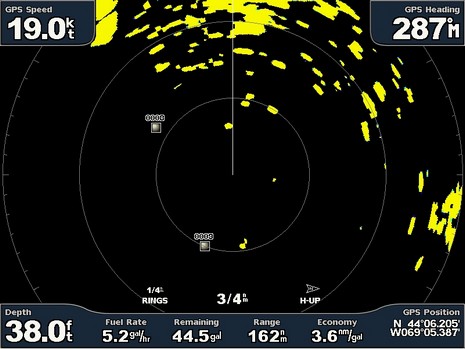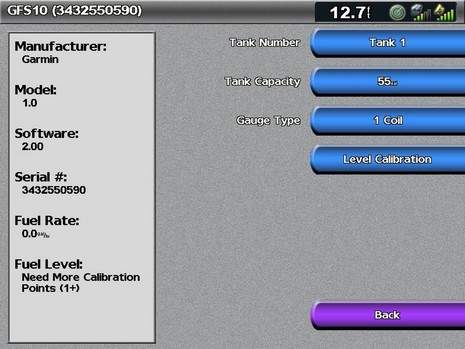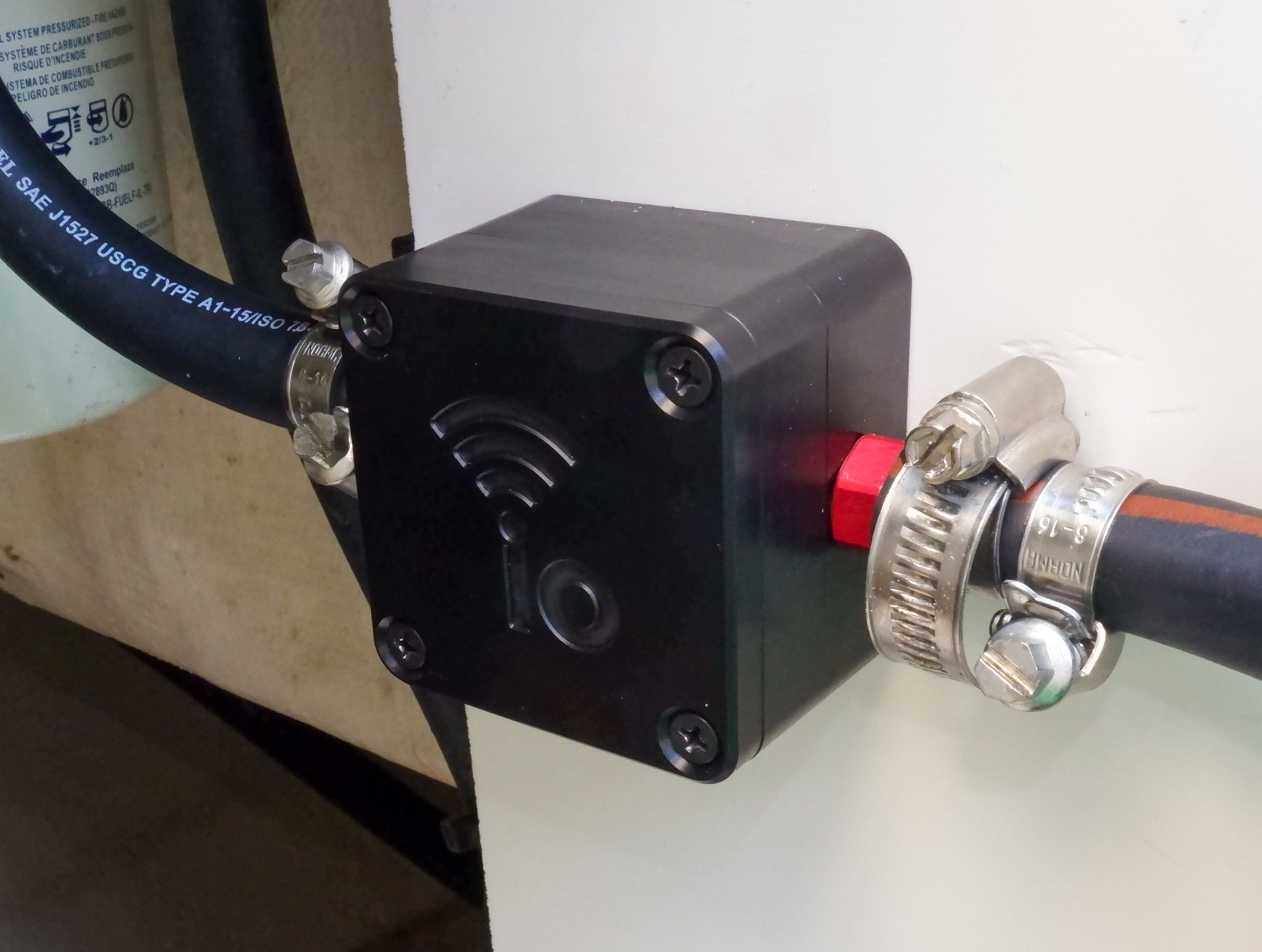Fuel management part one, Garmin

My first screen shots of Slancha’s Garmin 18” HD radar drew a lot of interest and I look forward to more experimenting with it later this week, but the real subject of the shot above, and this entry, is the fuel management information shown on the bottom bar. The boat’s owner, Peter Smith, installed a GFS 10 fuel sensor on the system’s NMEA 2000 network, and he’s tickled with the results, particularly the miles-per-gallon info, which has shown him where the sweet spots are on his power curve. That “Economy” number—a calculation based on flow versus Speed over Ground (from GPS) or Speed through Water (your choice)—may change with the boat’s load, bottom growth, sea conditions, or engine tune, but he’ll be able to see it happening.
Gasoline fuel flow—which is all the GFS 10 will do, with a maximum of 50 gallons per hour (ouch), a minimum of 2 gal/hr—is easier to sense than diesel, because of diesel fuel return, but all fuel management is a little more complicated than it might first appear. For instance, what exactly does “Remaining” fuel mean? Is it derived from the tank level sensor—i.e. a set tank size divided by its sensed percentage of fill—or from a set amount of fuel minus the sensed fuel flow? In the Garmin case, and maybe all fuel management systems, “Remaining” fuel as well as “Range” is based on flow. That’s good because it doesn’t vary as a tank moves around underway.
But live tank level is also useful, like when you’re fueling up with the engine shut down. The Garmin will give you that too, as long as you have the GFS 10 wired to a tank sender, or if the display is getting tank level PGNs from, say, a Maretron NK2 Tank Adaptor. But what if the tank level and flow-based remaining fuel indicate significantly different amounts? Well, that must mean that one or both of the sensors needs calibration, and the Garmin does a nice job of facilitating that. You can modify flow by plus or minus percentages, and you can set multiple tank level marks, which, like the Maretron TLA 100 routine, should take care of irregular tank shapes. Need I add that fuel management has suddenly become a much bigger deal, particularly here in the States? I’m already testing a pair of FlowScan FloNet diesel N2K interfaces with the lab’s network, and am hoping to get Lowrance’s well-developed fuel management on the water. More soon.














I like the idea, but I don’t understand the minimum flow rate of the sensors. 2 gal/hr for diesel would be about 33 hp. Does the boat’s engine burn that much while idling? My engine doesn’t burn that much at full load. Do somebody make sensors suitable for small diesel engines?
Yeah what he said… really I mean that.
OK, I have a question: If I have a GFS 10 connected to a GMI 10 via NMEA 2000, can I supply the GMI 10 with GPS information via NMEA 0183 and have the GMI 10 calculate and display the economy information?
norse,
I think Ben was stating that the minimum flow rate that the GFS 10 (suitable for gasoline use only) can sense is 2 gal/hr.
The only source for diesel fuel flow devices on the market right now is FloScan. Their website (http://www.floscan.com) has a great tool that will help select which senders (forward and return flow) are appropriate for your specific engine model. FloScan has sensors for a VERY WIDE range of engines.
Joe
Also many of the new Tier II and later motors have the Canbus interface on it. I’m working on using the maretron J1939 bridge which will convert that Canbus info to NMEA 2000. The end result will be gph, temp, rpm, etc all on my Navnet 3d whenever it comes.
Here’s the link to the bridge.
http://www.maretron.com/products/j2k100.php
I am fitting the nmea 2000 floscan system to the navnet 3d system i installed the other week.
Shall post how it goes and what looks like !
Andy
Right, Floscan has sensors for diesels from 25 to 6000 hp. Their minimum flow rate is 1 L/h or 0.3 gph.
Does not Lowrance feature this as well? I have just bought a lcx-27 with a nmea 2000 fuel flow sensor. But I have not yet found the “economy” in the instruments.
Filip, Lowrance does a terrific job with fuel management, and can display miles per gallon (“economy”) for individual engines, and total.
What happens with the Garmin system if you are burning less than two gallons per hour? Doesn’t
sound good for accurate fuel management.
Most (smaller boats anyway) burn less than
2 gph trolling. Mine burns around one.
I have the Lowrance system that will get dowm
to about 1/2 gallon per hour.
As to the less-than-2GPH sensing: the GFS10 will read below that, down into .2GPH and below, but I think the accuracy falls way off below the 2GPH number. Correct me if I’m wrong Ben, but I think 2GPH is the lowest rate Garmin will stand by. On Slancha the gage is still not fully calibrated, and the sensor was “field engineered” last year because it read half when the tank was empty (ran out of gas the first day out in the new boat). We pulled the sending unit and bent the float lever arm until the gage roughly matched the tank level, which got me through the season, but there’s more work to do there. I will install a better (NMEA2K) sending unit when I figure out which is the right one. Overall I’m very happy with all the new Garmin gear on the boat, most of it worked nearly perfect right out of the box, needing only minor tweaking. A really complete system for a reasonable price, and great support from Garmin and Panbo.
Two outboard engines on a small cruising cat is fairly common, found on PDQs, Seawinds, Mainecats, some Gwmini, and others. We are just as concerned about fuel consumption as others, so I hope that some enterprising manufacturer is exploring flow sensors for the half-gallon-an-hour crowd too!
I’m not bothered about the lack of accuracy since I do my fuel planning based on many trials of time and distance vs. fuel used to fill up the tanks. I do not rely on fuel level or fuel used gauges to plan a trip.
I use an economy display in NM/Gal to determine the relative fuel economy of various RPM/Trim combinations. Being able to see in real time the effect of changes is great, especialy on a boat with a planing hull.
Raul
On the “squeeze every gallon” front, I recently installed a Sting Ray hydrofoil on Slancha’s Honda 130, bolting it to the lowest cavitation plate as per the instructions. Though the manufacturer’s claims were obviously bogus (40% better fuel economy, 10+kts more speed etc.), I was really curious about the lower planing speeds offered. I’m happy to report the lower planing speeds are impressive, but I acutally lost about 4kts and 2-400rpm off the top end (where I rarely run anyway). The best part is the total lack of bow rise from dead stop to full throttle. This has effectively opened up that previously plowing speed range (7-13kts) as usable for cruising, allowing some fuel saving and possible dinghy towing not possible before. Well worth the $50.00 and four holes drilled in the motor. I also noticed appreciable lift to the stern in chop, with less “wallowing” and I think overall more efficient (and comfortable) running.
As a confessed Panbot and tinker-er, who can’t leave well enough alone, I’m considering “improvements” to the design and installation of the wing. I’ve got a nice piece of fiberglass coach roof cut out from my hatch that will make fine experimental hydrofoil stock…
Peter
I think I can speak as to the inaccuracy of the GFS10 at 1000 miles)- obviously not accurately measuring the flow. Now on plane, it seemed to be plausable at say 3.5 to 3.7 mpg and cruise of 140-150.
Regarding the Garmin GFS 10 fuel flow sensor, others have said that once the turbine is spinning, after throttling up to at least 2 GPH, it will continue turning and indicating flows of less than 0.5 GPH which is comparable to Lowrance fuel flow sender. My engines are tiny; therefore, I need some accuracy at engine speeds below 2000 RPM.
Is it true that the turbine will keep spinning and indicating flows far below Garmin’s specs of 2 GPH?
Any help appreciated since I would prefer to stay with Garmin if possible and not have to buy a whole new Lowrance system.